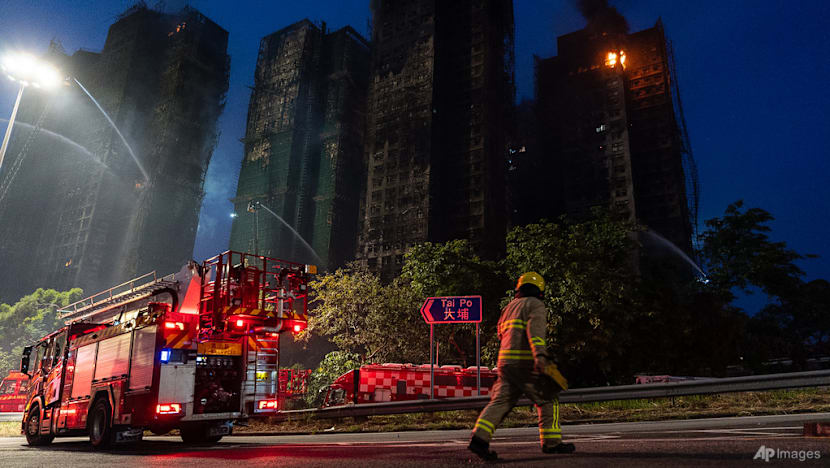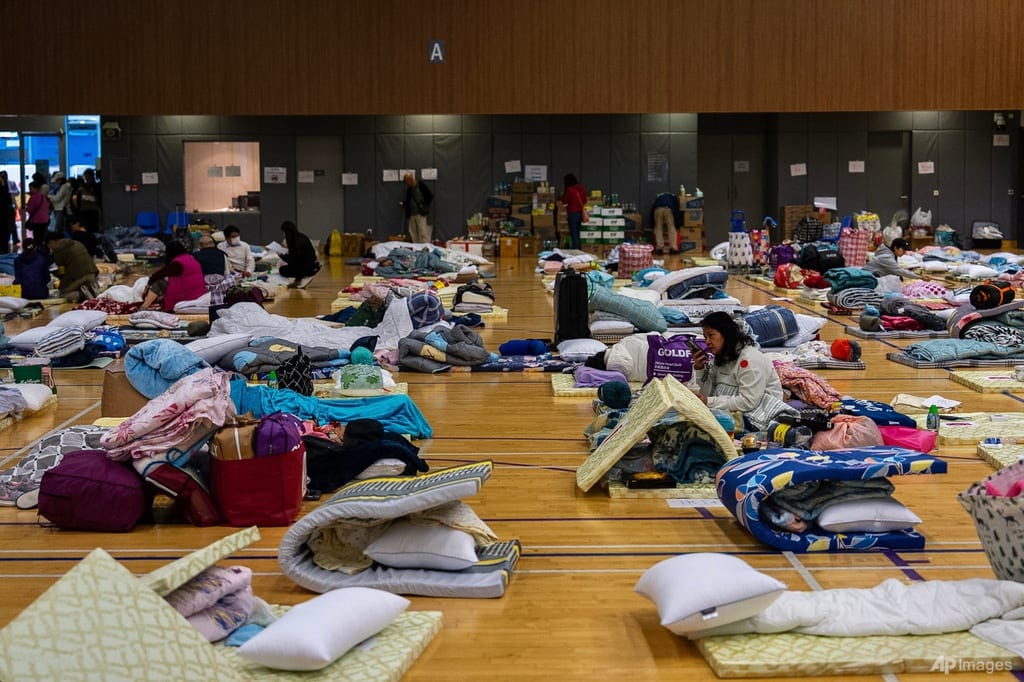What we know about Hong Kong's deadly high-rise fire
How did the fire start and what could have caused it to turn so deadly?

A firefighter walks past the fire scene at Wang Fuk Court, a residential estate in the Tai Po district of Hong Kong's New Territories, Thursday, Nov 27, 2025. (Photo: AP/Chan Long Hei)
HONG KONG: A devastating fire tore through a Hong Kong high-rise residential complex, killing dozens of people with hundreds still missing.
The inferno - the financial hub's worst in decades - sent shock waves through the city, which has some of the world's most densely populated and tallest residential blocks.
Here's what we know about the fire so far:
WHERE IT OCCURRED
Intense flames burned on bamboo scaffolding on several apartment blocks of Wang Fuk Court, a residential complex undergoing renovation in the northern district of Tai Po, on Wednesday (Nov 26).
The blaze rapidly engulfed several towers at the housing estate, which includes eight buildings of 31 floors each and has a combined total of 1,984 units.
Only one block was not affected by the blaze.
Wang Fuk Court is one of many high-rise housing complexes in Hong Kong. Tai Po, located near the border with mainland China, is an established suburban district with about 300,000 residents.
Occupied since 1983, the complex is under the government's subsidised home ownership scheme, according to property agency websites.
According to online posts, it has been undergoing renovations for a year at a cost of HK$330 million (US$42.43 million), with each unit paying between HK$160,000 and HK$180,000.

WHAT CAUSED THE FIRE?
The inferno has put the cityβs use of flammable scaffolding and mesh for building work under the spotlight.
The original source of the fire is not clear but investigators were already probing the installation of flammable materials during the construction on the buildings as a potential factor in the dramatic escalation of the blaze.
Police have arrested three men from the construction company involved, accusing the firm of gross negligence leading to the accident and causing the fire "to spread rapidly beyond control".
The external walls of the soaring residential towers were covered in bamboo scaffolding and wrapped in netting and plastic sheeting.
Police said after preliminary investigations, they suspected many of those materials did not meet fire safety standards.
Investigators also found packaging foam at the site, which they said was highly flammable and could have contributed to the quick progression of the blaze.
Hong Kong's anti-corruption agency ICAC said it has set up a task force to carry out a comprehensive investigation into potential corruption involving the Wang Fuk Court renovation project.
Breezes of around 14kmh were recorded in the area around the time the fire started on Wednesday afternoon.
Hong Kong's leader John Lee said a task force had been set up to investigate the cause of the blaze.
"Buildings Departments' independent review unit will investigate whether the building's exterior walls meet the fire retardant standard," he told a press conference on Wednesday.
"If there's any wrongdoing we'll pursue accountability in accordance with laws and regulations."
He also said the government will take special action against ongoing projects, checking whether scaffolding mesh materials meet fire-retardant standards and other safety standards.
Up to 100 contractors for building complexes across Hong Kong will have seven days to submit documents proving the use of fire-retardant materials, he added in a late afternoon press conference.

EXPERTS WEIGH IN
Some residents have told the media that the fire alarms in the buildings did not go off when the fire started.
But why did the blaze spread so quickly?
The key question may not be what started the fire, but why it spread so fast, said fire safety engineering lecturer Anwar Arabi.
Hong Kongβs signature bamboo scaffolding βcompletely negatedβ the possibility of the fire being contained within a compartment, he said.
βThe fire had a way to travel from one floor to the other, uninterrupted,β he told ΒιΆΉβs Asia Now programme.
βInside a building, normally, when it's not under renovation, we seal even the ducts that allow wires to go through, because we want to prevent any fire. But when you have flammable scaffolding on the outside, that completely negates the point.β
Such bamboo scaffolding was already being phased out in Hong Kong due to concerns like fire safety, said the University of Queensland expert, who has several years of teaching and academic experience in Hong Kong.
Hong Kong has one of the worldβs most expensive real estate markets, where space is limited and high-rise buildings are part and parcel of the landscape.
This means families are living in very small spaces with βlots of fuel accumulatingβ, said Arabi.
βEvery apartment actually becomes β¦ so full of fuel that it is able to burn and generate heat that continues to propagate the fire.β
Arabi compared it to Grenfell Tower fire that broke out in 2017, which became the deadliest fire in Britain in more than a century. The high-rise blaze killed more than 70 people.
βWhen the fire is outside and spreading vertically, that's how fire likes to spread, because of buoyancy. So the fire will tilt and will touch the solid, causing the solid to degrade and release combustible gases that will allow it to spread,β he explained.
βSo the fact that we see it spreading vertically at such a fast pace is, to me, to be honest, not very surprising - although the fact that it happened is really unfortunate."
Professor Guan Yeoh from the School of Mechanical and Manufacturing Engineering at the University of New South Wales in Sydney told ΒιΆΉ that fire safety must remain a top priority in construction.
He added that urban construction practices should consider moving away from bamboo scaffolding and mesh in favour of sturdier metal scaffolding and clamps, stressing the importance of conducting a thorough review of bambooβs fire safety properties.
If bamboo poses significant risks, it should be replaced with safer alternatives, he said.
Housing researcher Yau Yung, associate dean of Lingnan University's School of Graduate Studies, said the blaze exposed several issues that require urgent review.
Beyond construction practices, he emphasised the need for better public education on emergency preparedness.
Many elderly residents may not know how to respond during a fire, and their caregivers β often domestic helpers from countries without high-rise living β may also be unfamiliar with evacuation procedures.
Strengthening community education, he said, will be essential to preventing future tragedies.
CASUALTIES
According to the Fire Services Department as of 8pm on Thursday, the blaze has killed 75 people, including a firefighter who died while battling the blaze.
Two Indonesian migrant workers were also among the fatalities. A total of 70 people were injured.
Eight hydraulic platform trucks, 11 fire hoses, 304 fire and rescue vehicles, and more than 1,250 firefighters are involved in the firefighting operation. Four low-altitude drones had also been deployed to monitor for the possibility of flames reigniting.
Authorities have set up temporary shelters for residents who had to evacuate their homes.
On Thursday afternoon, the 10th such shelter was opened.
More than 500 residents were staying at the other nine shelters, according to the latest update by Hong Kong's government.

PREVIOUS MAJOR FIRES IN HONG KONG
The blaze is the cityβs deadliest fire in decades.
In November 1996, 41 people died in a commercial building in the Kowloon district.
On Aug 2, 1962, a fire in the Sham Shui Po neighbourhood of Kowloon also killed 44 people.
Hong Kongβs worst fire death toll in history saw more than 600 people killed at the Happy Valley racetrack in 1918.
TIGHTLY PACKED CITY
Hong Kong is one of the most densely populated places in the world, making urban disasters a significant risk.
Its 7.5 million residents are squeezed into islands covered in steep hills.
The city's population density is more than 7,100 people per sqm of land, on par with packed metropolises like Tokyo.
VERTICAL LIVING
The financial hub is famous for its dramatic skyline of skyscrapers set against a picturesque harbour, many of which are home to residents as well as banks and commercial offices.
The city's construction boom in the past decades has been largely fuelled by residential towers to house its growing population.
Much of the new residential development in recent decades has been in the New Territories, the area where Tai Po is located.
Hong Kong has 569 buildings above 150m, the most in the world, according to a tracker from the Council on Tall Buildings and Urban Habitat.











